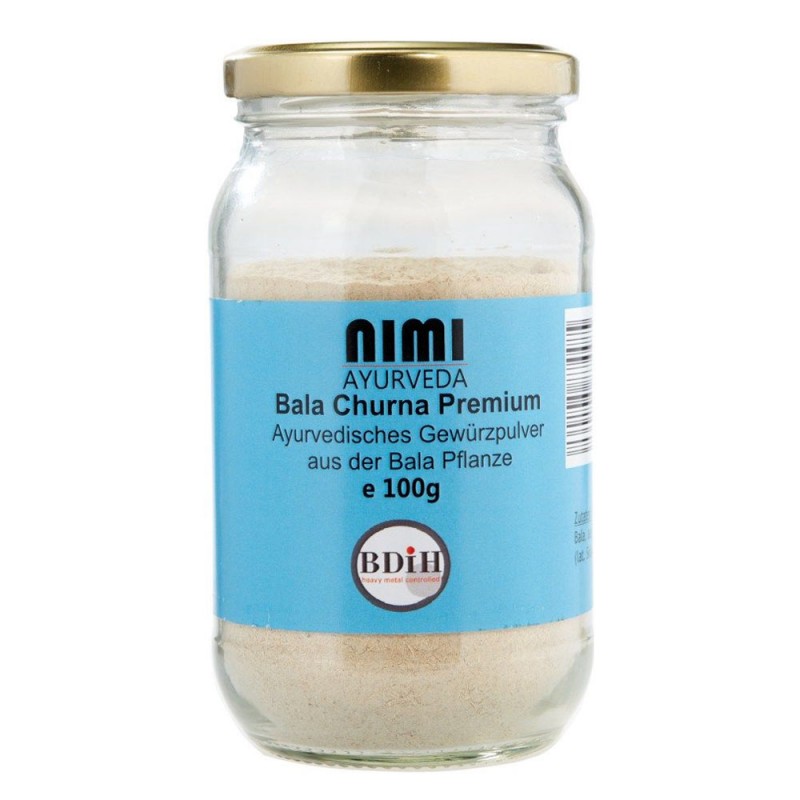- −-25%



Bala Indian Mallow Churna Powder is a spice powder also known as Vatyalika Churnam or Kharayashtika Choornam. It is often used in Ayurveda for its Vata and Pitta dosha-reducing properties.
The name Bala also means strength or energy.
Best before 2025-09-30


"Bala Indian Mallow Churna powder is a spice powder also known by the names Vatyalika Churnam or Kharayashtika Choornam. It is often used in Ayurveda for its Vata and Pita dosha reducing properties.
The name Bala also means force or energy.
In India, athletes often use Bala to support their training. Especially among strength athletes, it seems to be a kind of "secret tip" there. However, if we take into account that Bala means 'strength', the advice is not so secret.
"Bala Indian Mallow Churna Bio is of very pure, laboratory-tested quality and consists only of the plant parts shown in Ayurvedic texts. It is processed and produced in strict accordance with Ayurvedic guidelines.
Method of use:
For internal use (according to Ayurvedic treatises): 0.5 teaspoon (2.5 g), 2 times a day with warm water or milk before or 40 minutes after meals or with food, or mixed.
Traditional Ayurvedic Bala recipe:
Boil 250 ml of water with 125 ml of milk, add 1/2 teaspoon of Bala Churna, 1/2 teaspoon of Ayurvedic sugar (e.g. Sharkara) and a pinch of ginger. Boil this mixture over low heat until the volume is reduced to 250 ml.
This decoction is taken early in the morning immediately after getting up.
Bala recipe for men:
Boil 250 ml of water with 125 ml of milk, add 1/2 teaspoon of Bala Churna, 1/2 teaspoon of Ashwagandha, 1/2 teaspoon of ghee and 1/2 teaspoon of ayurvedic sugar.
In the Bala recipefor women, Ashwagandha is replaced by Shatavari.
Contraindications: individual intolerance to ingredients, pregnancy, diarrhoea, hypertonicity. It is recommended to consult an Ayurvedic practitioner before use. Avoid overdose.
Ingredients: Sida cordifolia powder.
Net content: 100g
Storage conditions: Store in a dry, cool, dark place out of the reach of children.
ABOUT GROWTH:
Sidá(Sida), a genus of plants in theMalvaceae family. About 150 species are known. Sida is widespread in Africa, Asia, South and North America, Australia, the Pacific Islands, tropical and subtropical areas. The greatest diversity is in South America. An annual or perennial herb, semi-shrub or low shrub covered with starry, common and glandular hairs. Leaves are simple, continuous or lobed, lanceolate, ovate, rhombic or cordate. The flowers are one or two in the axils of the leaves, sometimes clustered in clusters, clusters of clusters, panicles or heads. There is no pistil and the calyx is bell-shaped or bowl-shaped. The corolla is yellow, less often white or orange. Fruit is a cleaved fruit with 5-10 mericarps. Long-leaved sida (Sida cordata), heart-leaved sida (Sida cordifolia), spiny sida (Sida spinosa) are medicinal plants with a high concentration of water-soluble hydrocarbons and are used in modern and folk medicine. The common sida (Sida hermaphrodita) is cultivated as a fibre, energy and ornamental plant. Some species of sida are crop weeds in tropical and subtropical regions. There are no native species in Lithuania, but there are 2 rare alien species, the speckled sida and the rhombus sida (Sida rhombifolia). The common sida is sometimes cultivated in flowerbeds.
 Vegan
Vegan
 Gluten free
Gluten free
 Organic
Organic
 Vegan
Vegan
 Gluten free
Gluten free
 Herbal food supplement
Herbal food supplement
 Organic
Organic
 Authentic Ayurveda
Authentic Ayurveda